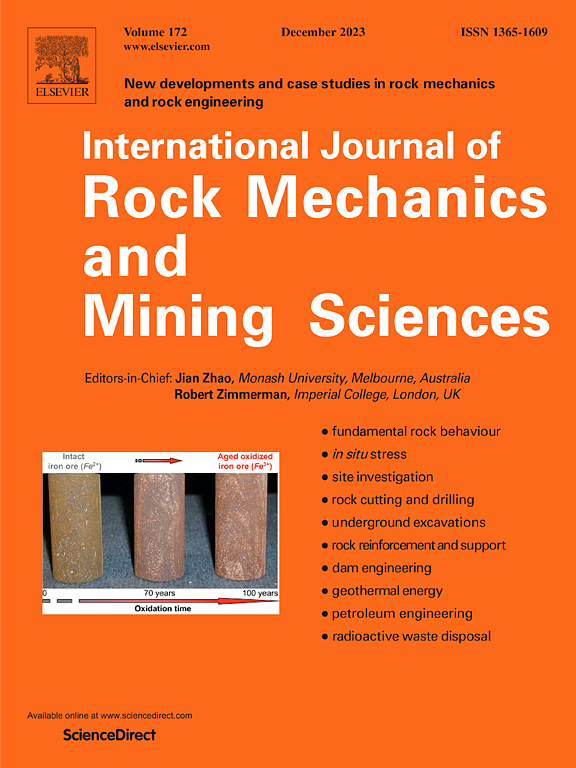Predicting three-dimensional roughness of rock discontinuity based on limited outcrop information during tunnel construction
IF 7
1区 工程技术
Q1 ENGINEERING, GEOLOGICAL
International Journal of Rock Mechanics and Mining Sciences
Pub Date : 2025-02-12
DOI:10.1016/j.ijrmms.2025.106040
引用次数: 0
Abstract
Three-dimensional (3D) roughness of the rock discontinuity plays a controlling function on the rock mass stability of excavation face during deep buried tunnel construction, which can be predicted based on the discontinuity outcrop from excavation face. However, there exist some disturbing factors such as dust and debris which affect the non-contact measurement accuracy on the outcrop information under construction environment. In this study, a new method to predict three-dimensional roughness of rock discontinuity (JRC3d) based on the limited outcrop and drilling test information from the rock mass of excavation face is proposed. Two-dimensional roughness of rock discontinuity (JRC2d) is derived based on different asperity orders firstly. The first-order profile roughness is calculated by combining drilling test result, and the second-order profile roughness is predicted on establishing the statistical relationship between the geometrical parameter of the outcrop and the entire profile. Based on the prediction of JRC2d, JRC3d is characterized probabilistically with the improved Bayesian theory where the bootstrap method is used to deal with the difficulty of obtaining μ and σ of the prior distribution because the sample size is limited. A rock tunnel engineering in southwest China is taken as the engineering application, and the relative errors of the predicting JRC3d are lower than 11 %. Finally, the effect of outcrop width on the predicting JRC3d results is investigated. For Barton standard profiles, the statistical parameters of the first k climbing angles of the second-order roughness profiles are calculated to estimate the appropriate outcrop width as 16 mm. A rock discontinuity is generated to study the effect of discontinuity size on the predicting JRC3d, and the relative error of the predicting JRC3d is lower than 12 %, thereby validating the method applicability across a broad spectrum of discontinuity sizes, ranging from small to large.
基于有限露头信息的隧道施工岩体结构面三维粗糙度预测
在深埋隧道施工过程中,岩体结构面三维粗糙度对开挖工作面岩体稳定性起着控制作用,可根据开挖工作面结构面露头进行预测。但是,施工环境下露头信息的非接触式测量存在粉尘、碎屑等干扰因素,影响测量精度。本文提出了一种基于开挖工作面岩体有限露头和钻孔试验信息的岩体三维粗糙度预测方法(JRC3d)。首先基于不同的粗糙度阶,推导了岩体结构面二维粗糙度(JRC2d);结合钻孔试验结果计算了一阶剖面粗糙度,建立了露头几何参数与整个剖面的统计关系,预测了二阶剖面粗糙度。在JRC2d预测的基础上,利用改进的贝叶斯理论对JRC3d进行了概率化表征,利用自strap方法解决了样本容量有限而难以获得先验分布的μ和σ的问题。以西南某岩巷工程为工程应用,JRC3d预测的相对误差小于11%。最后,研究了露头宽度对JRC3d预测结果的影响。对于Barton标准剖面,计算二阶粗糙度剖面的前k个爬坡角的统计参数,估计出合适的露头宽度为16 mm。通过生成一个岩体结构面,研究了结构面尺寸对JRC3d预测的影响,预测的相对误差小于12%,从而验证了该方法在从小到大的广泛的结构面尺寸范围内的适用性。
本文章由计算机程序翻译,如有差异,请以英文原文为准。
求助全文
约1分钟内获得全文
求助全文
来源期刊
CiteScore
14.00
自引率
5.60%
发文量
196
审稿时长
18 weeks
期刊介绍:
The International Journal of Rock Mechanics and Mining Sciences focuses on original research, new developments, site measurements, and case studies within the fields of rock mechanics and rock engineering. Serving as an international platform, it showcases high-quality papers addressing rock mechanics and the application of its principles and techniques in mining and civil engineering projects situated on or within rock masses. These projects encompass a wide range, including slopes, open-pit mines, quarries, shafts, tunnels, caverns, underground mines, metro systems, dams, hydro-electric stations, geothermal energy, petroleum engineering, and radioactive waste disposal. The journal welcomes submissions on various topics, with particular interest in theoretical advancements, analytical and numerical methods, rock testing, site investigation, and case studies.

 求助内容:
求助内容: 应助结果提醒方式:
应助结果提醒方式:


